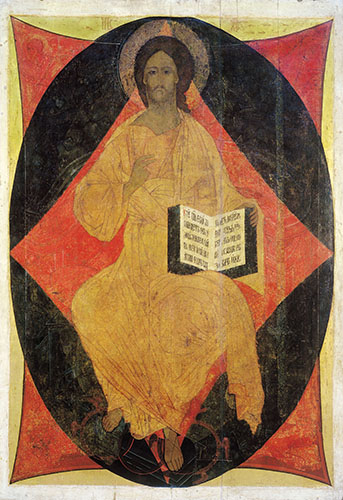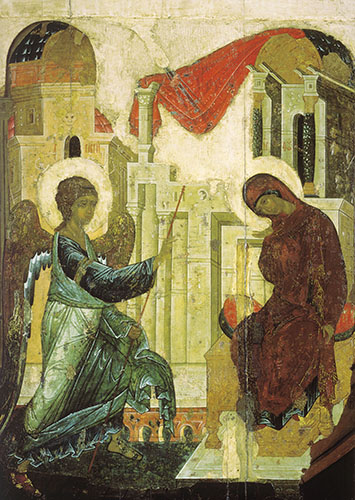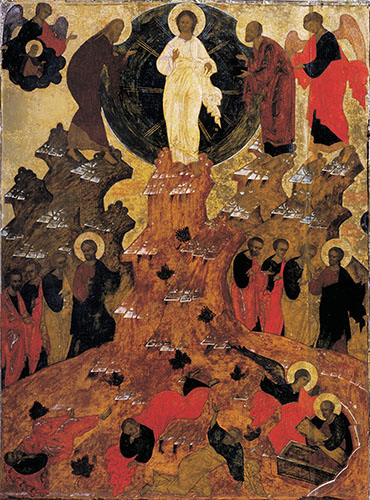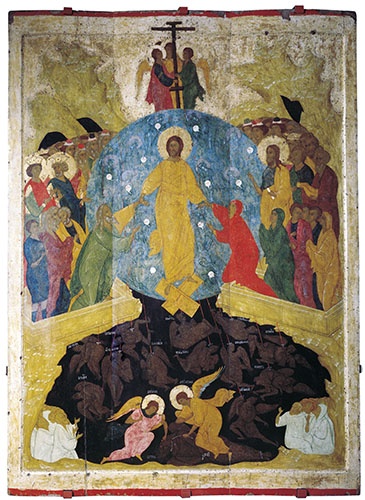No man on earth can behold the face of God and live; therefore, coming among us, our God assumed flesh.
In the beginning, God created heaven, the earth, the sea, and all things therein. He fashioned Adam, the first man, according to His own image and likeness: pure, guileless, and righteous. Placing man in a paradise of delights, God fashioned a helpmate for him from his rib. Unable to endure the sight of man enjoying such blessedness, the devil led astray Eve, the first woman, and through her persuaded Adam to transgress the Lord’s commandment. Adam and Eve were expelled from paradise and had sons and daughters, so that their descendants filled the earth. Because of sin’s entry into the world, the human race became subject to death, and all our forefathers, righteous and unrighteous, descended to Hades. As Christ’s Apostle wrote: Death reigned from Adam even over them that had not sinned after the similitude of Adam’s transgression.
He sent His Son to assume human flesh and save Adam and those chained in Hades with Adam. A prince of the angels named Gabriel proclaimed to the holy, immaculate, most honorable Virgin the Incarnation of the Son of God, Who is the Word begotten of the Father before all ages: His wisdom, power, and right hand. The archangel announced to the Virgin, that scion of prophets and kings, Hail, thou who art full of grace, the Lord is with thee, and, The Holy Spirit shall come upon thee, and the power of the Highest shall overshadow thee: therefore also, that holy thing which shall be born of thee, shall be called the Son of God. At this the Word of the Father, being God Himself, invisibly took up His dwelling in the most pure and sanctified womb and became flesh. The Son of God and Word of the Father was born of the blameless Virgin; He was clothed in a body for the salvation of man. No one can see the true God as He is according to the divine essence, for God is a consuming fire. No man on earth can behold the face of God and live; therefore, coming among us, our God assumed flesh. He was born and as a babe was nurtured with milk, while remaining perfect God. As a child he grew in stature, until He reached full manhood. He lived among men for thirty-three years. He passed through towns, villages, and countryside, preaching the Gospel to all and freeing those under the power of the devil. Then He willingly submitted to crucifixion in order to save the world, which was perishing in demonic deception. Having died in the flesh, He descended with His holy soul into Hades, crushed the brazen gates, and shattered the iron bolts. He broke the fetters with which the devil had bound his captives, and He led the souls of the saints out of darkness and up to heaven. On the third day after His crucifixion, He rose from the dead in the flesh, appearing to His disciples (called the apostles) and to many others who truly believed in Him. During the course of forty days, He ate and drank often with the apostles, then ascended into heaven, where He sits in the flesh on the right hand of God the Father. Now He reigns on high, and the Christians trample the devil as they enter the Kingdom of heaven…”Therefore, our Heavenly Father, God Almighty, took pity on the race of man, and rescued us.








